|
FAQs on Freshwater Angelfish Disease/Health
5
FAQs on Angelfish Disease:
Angelfish Disease 1,
Freshwater Angel Disease 2,
FW Angel Disease 3,
FW Angel Health 4, FW Angel Health 6,
FW Angel Health 7,
FW Angel Health 8,
FW Angel Health 9,
FAQs on Angelfish Disease by Category:
Diagnosis,
Environmental,
Nutritional (e.g. HLLE),
Social,
Infectious (Virus, Bacterial,
Fungal), Parasitic (Ich, Velvet...),
Genetic,
Treatments,
Related Articles: Freshwater Angels, Discus, Juraparoids, Neotropical Cichlids, African Cichlids, Dwarf South American Cichlids, Asian Cichlids, Cichlid Fishes in General,
Related FAQs: Angels 1, Angels
2, Angelfish Identification, Angelfish Behavior, Angelfish Compatibility, Angelfish Selection, Angelfish Systems, Angelfish Feeding, Angelfish Reproduction, & FAQs on:
Wild Angels (P. altum),
Cichlids of the
World, Cichlid Systems,
Cichlid Identification, Cichlid Behavior, Cichlid Compatibility, Cichlid Selection, Cichlid Feeding, Cichlid Disease, Cichlid Reproduction,
|
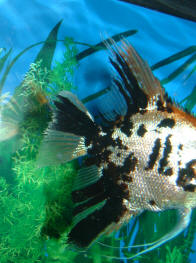
|
|
Re: Tiny worm-like parasite, FW Angels
1/21/10
Dear Neale,
<Amy,>
I began treatment for parasite infestation Jan. 18 evening. I
used a medication containing Praziquantel, diflubenzuron,
Metronidazole, and acriflavine according to the instructions on
the packaging. It was the only medication at any nearby fish
stores that advertized to get rid of anchor worms and copepods.
The parasite has cleared out (at least visibly), but there has
been drastic deterioration of the angel's fins. It looks like
he may have a secondary fin rot infection.
<Very probable. The anchor worms break the epidermis, and this
is how secondary infections get started.>
The dorsal and pectoral fins seem to have stabilized. However,
there is still some loss occurring on the anal fin and the caudal
fin is completely gone. Of the latter, all that remains are a few
rays and a very red and inflamed base.
<Yes, likely bacterial; treat promptly.>
Shortly after removing the carbon from my canister filter, the
ammonia and nitrate levels showed traces, but returned to normal
by morning.
<If the carbon was more than a couple of weeks old, it'd
be working as biological filter media (and the covering of
bacteria is precisely why carbon needs to be replaced with fresh
carbon every couple of weeks, at least, if you want it to work as
carbon). Removing biological media can knock back filter
efficiency if you don't leave enough live biological media
behind. Moreover, some medications can and do harm biological
filters, sometimes slightly, sometimes severely.>
All my other fish seem to be unaffected. Is it safe to do a
partial water change and start treating for fin rot (if that is
the problem)?
<Likely is.>
Should I try adding a bit of salt to the tank or dip?
<Salt pointless here. You do need a suitable anti-Finrot
medication.>
Any treatment suggestions would be greatly appreciated. Thank you
again for your time.
Sincerely,
Amy
<Good luck, Neale.>
|
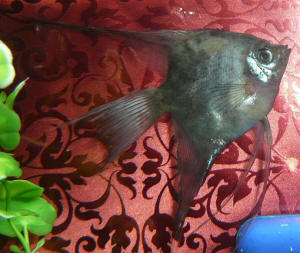 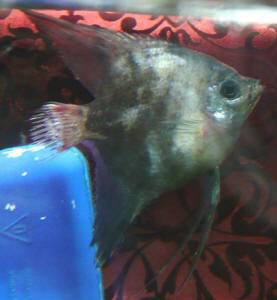
|
Re: Tiny worm-like parasite --
1/22/10
Dear Neale,
<Amy,>
I would like to thank you again for all the time you have
invested in answering my questions. If I may be so bold,
there are a few more I would like to ask...
<Fire away.>
The instructions on the anti-parasite medications advise a
48 hour wait before medicating again. I looked up the
active ingredients and it appears that at least one causes
kidney damage with prolonged exposure.
<Not a problem in this case. For one thing, freshwater
fish's kidneys work rather differently to our own, so
problems detected when medications are used in humans may
not occur with fish. Moreover, most medications sold for
use in aquaria have a very short lifespan in the aquarium,
typically becoming metabolised within a day. So while all
medications are poisons at some level -- including those
doctors prescribe for humans -- if used as described by the
manufacturer, there's little risk of causing harm to
your fish. Indeed, not using the right medication can end
up doing far more harm by allowing the pathogen free rein
to harm your livestock. So, in short, use a medication for
the full duration as described by the manufacturer.
Don't do half doses and don't skip days of
treatment on a whim.>
So, I plan on treating for fin rot (with Maracyn unless
there is something else you recommend)
<A useful medication, but strictly for bacterial
infections rather than worms. Do also note that most
medications are formulated to be used ALONE.
Mixing multiple medications in one aquarium is unwise.
Standard operating practise is to complete one course of
medication, do a 50% water change, and then start another
course of medication the following day. Some aquarists like
to run carbon in the filter overnight between the two
courses. Carbon removes organic chemicals, including
medications, which is why you always remove carbon (if you
use it) while medicating. In practise the carbon step
isn't essential because the bacteria in the filter will
metabolise unused medications quite quickly.>
tomorrow afternoon in hopes to save the healthy fishes'
nephrons.
<!!!>
However, there is no longer caudal fin to treat on the
adult angelfish.
<Can grow back.>
In addition, The base of the caudal fin is sloughing scales
and the remaining scales are protruding. To top it all off,
the bloat around his belly has worsened, there is red
speckling below his right pectoral fin, and fine scales are
protruding along the ventral side (the attached photo shows
his current condition). Again, water conditions are good
and none of the other fish show any signs of illness.
<Unfortunately, septicaemia is quite common once Finrot
has progressed down to the base of fins. Since this is an
internal bacterial infection, this is best treated with
antibiotics, preferably via food rather than added to the
water.>
Is it in the angelfish's best interest to continue
medicating, or am I prolonging the inevitable?
<By no means; given treatment, there is a chance the
fish will recover.
Very small fish rarely do, but Angelfish are just large
enough they might pull through.>
If the infection has gone septic, will a fin rot treatment
be effective?
<Finrot medication that acts externally will not have
much impact on septicaemia. Maracyn by itself isn't
particularly useful, but Kanamycin Sulfate and Aquarium
Pharmaceuticals Triple Sulfa have both been used
successfully. Follow the instructions on these
carefully.>
If he does pull through, is there a reasonable chance that
he will see any regrowth?
<Fins can regrow provided at least some of the bony rays
remain.>
Lastly, does the bloat indicate that there is already
irreversible kidney damage?
<Not necessarily.>
Thank you again for your time and expertise.
Sincerely,
Amy
<Good luck. Cheers, Neale.>
|
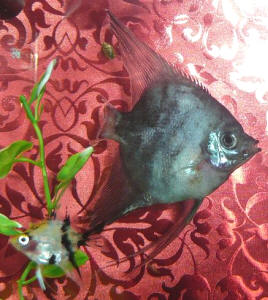 |
|
Re: Tiny worm-like parasite
1/26/10
Dear Neale,
<Hello Amy,>
I completed the full treatment for parasites on Jan. 22.
Afterward, I performed a 50% water change, ran 12 hours
with fresh activated carbon, removed carbon and began
treatment for the secondary bacterial infection using
medicated foods. January 24th and today, I performed 25%
water changes because the nitrogenous waste levels showed
traces ( far from "dangerous").
<Anything non-zero is stressful, and the degree to
which it is "dangerous" depends on the health
and type of fish.>
Last night, the adult angelfish regained his color and
there was about 2mm of visible fin ray growth.
<Cool.>
The bloat has been steadily declined over the past three
days.
<Good.>
However, this morning I found him upside-down with his
mouth in the gravel, but sill has visible gill
movements.
<Oh!>
This is where he has been all day.
<Do check water quality, and take a look to make sure
things like the heater and filter are working. It's
obvious I know, but you'd kick yourself if they were
the thing.>
I noticed strange coloration along the base of the caudal
fin and just ventral from the pectoral. Is this something
new, or is it related to one of the other ailments?
<Impossible to say.>
Thank you again for your time and advice.
Sincerely,
Amy
<I suspect this is the make or break point. If the
infection is systemic, honestly, there's little you
can do, and painless destruction may well be appropriate.
But if he starts to show signs of recovery, then you may
be
okay. I have seen fish come back from the brink, and
doing things like increasing oxygenation and keeping the
water spotlessly clean are major factors. Nothing much
else I can add. Good luck, Neale.>Re: Tiny worm-like
parasite
Re: Tiny worm-like parasite 1/27/10
Dear Neale,
I am sorry to say that the adult angelfish did not pull
through.
<Sorry to hear that.>
When I removed him from the tank, some of the pigmented
skin sloughed off and it was apparent that there was
internal bleeding underneath. Also, there was a pool of
blood behind one of his nostrils. All of my black
neon
tetras and the juvenile angel show no signs of illness
and have been leaving the adult angel alone.
<Good. Does sound like a systemic bacterial
infection.>
The pH has been between 7.8 and 8 (characteristic of the
water table), ammonia has not been over .25,
<Still potentially dangerous.>
nitrites have not reached .1,
<When nitrites are substantially less than ammonia,
that tends to imply an aquarium isn't properly
cycled, and that can easily cause problems.>
and nitrates between 5 and 15. Could the antibiotic food
(Jungle brand)
leach into the water and effect my nitrogen cycle?
<Potentially, but unlikely.>
How long should it take to give my fish the "all
clear" if no symptoms develop and my ammonia and
nitrites are back to 0 (should I wait longer than an
average quarantine)?
<Well, cycling takes about 6 weeks from scratch, and
rather less if the tank is at least partially
cycled.>
Thank you for all your help through this. I have been
bewildered as to the cause of most if it.
Sincerely,
Amy
<All I'd do was assume a problem with water
quality, allow the filter to re-cycle before adding any
more fish, and to be careful with food, so there's no
risk of uneaten food causing problems. Review stocking
density, and make sure the filter is appropriate to the
task in hand. Check there's enough circulation and
you have a sensible balance of biological media to the
other types. Cheers, Neale.>
|
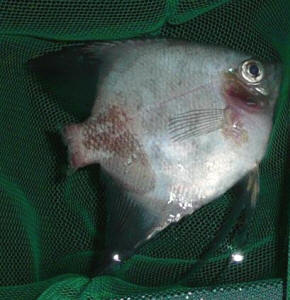 |
|
FW angelfish in distress --
01/17/10
My breeding male golden angel suddenly started gasping for air at the
of the tank. This went on for about 4 days and I dropped in 2 extra
bubblers to produce more oxygen. I found him finally at the bottom of
the tank between a piece of slate and the tank wall. (it is a 55 gallon
tank with just his female mate and a couple of lemon tetras, one large
clown loach and an African butterfly fish). All the other fish seem
healthy. This fish stayed behind the slate for a couple of days when I
decided to isolate him in a smaller tank, bump up the heat a little and
give him lots of aeration.
<Good moves>
He is still lying on the bottom of this tank, not looking too happy.
Hasn't eaten in days. I know it's probably something to do with
his swim bladder
<?>
but I just don't know what to do for him next. He's a pretty
hardy guy and survived a very bad injury about a year and half ago, but
he has bred many times since and has healed and been in perfect health
until now. Any suggestions, it's hard to watch him suffer.
Thanks,
Suzi
<It is odd that the other angel is not mal-affected by
"whatever" the root cause is here; if it were some sort of
biological disease... I would just continue as you have, with the
improved conditions, and hope for the best.
Bob Fenner>
|
Angelfish fins 1/15/10
hello all...
<Hello,>
I have several angels that look to have ragged fins.
<As is their wont. There are three things to consider.
Firstly, genetics.
Anything "veil tail" is likely to have raggedy fins.
These fish didn't evolve to have such long fins as some
breeders deem attractive, and things like their blood supply
can't necessarily cope with the extra burden. The end result
is that long-finned fish very often have raggedy fins. The second
issue is tankmates. Angelfish are a sitting target for nippy
fish: tiger barbs, Serpae tetras, and so on. Arguably, they are
best kept alone or with species unlikely or unable to attack
them, such as Corydoras.
Finally, there's water quality. Like all fish, Angelfish are
stressed by poor water quality, and one symptom of such stress is
Finrot. At a low level this manifests itself as erosion of the
membrane, with the fin rays (the bones) being left behind a bit
longer, so you see a distinctive raggedy, cobweb-like edging to
the fin.>
I have had most for almost two years and haven't noticed the
severity before. I understand they cant have perfect fan tails
all the time but it seems this may be a bit extreme. I have had a
close call with my tank almost crashing (bad water quality) and I
dont know if they are just recovering from that.
<Could very easily be.>
I have never had fin rot, with this tank or any others before so
I dont know how to tell if its just recovery stress or something
else. no other symptoms...eating well, swimming fine. just the
fins...55 gal aquarium and the water quality is great. nitrates
2.0, ammonia & nitrites 0, ph 7.2. here are some pics. it
just looks bad. thanks
<Wouldn't necessarily treat with anti-Finrot medication
just yet, but would review tankmates and water quality. If
nitrite and ammonia levels are zero, and nitrate less than 20
mg/l, the fins on these fish should heal by themselves. If
there's no sign of healing, and the fins clearly get worse,
would treat with a suitable antibiotic or antibacterial. Cheers,
Neale.>
|
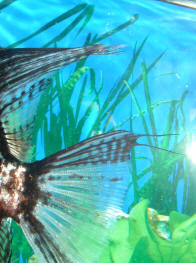  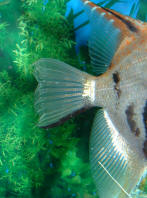 |
|
Re: angelfish fins --
01/17/10
ok, I will monitor the angels and see how they are...how long do
you suggest it give them if I dont notice a change? a week or
so?
<A week or two. Obviously, if it gets *worse* within that time
frame, you have a problem.>
also, I have gold barbs that get red circular spots on them, like
a sore.
they come and go, then where it is healed is a white spot on the
scales, like a scar. not sure if this has anything to do with it
but is this something I should watch also?
<Not sure what these are, but I'd check water quality
first of all. If there's any trace of ammonia and/or nitrite,
assume Finrot, and fix water quality problems. With luck, that
should prevent any reoccurrence. If the water is fine, then you
might think about possible parasite infections. Ick (Whitespot)
for example bursts through the skin when mature, and this
eruption can allow secondary infections.>
several have had these mysterious red sores for the last few
months, here and there.
thanks
Lisa
<Please do use some capital letters next time. It's rather
tedious reading messages that are all in lower case! You're
also likely to give a poor impression to any passing
psychiatrists! Cheers, Neale.>
Re: angelfish fins
1/19/10
Ok...Capitals it is. I was lazy and type quicker when I
don't use caps...I had a thought yesterday. Could the
fins of my angels be nipped off?
<Yes. Black Widow tetras, Gymnocorymbus ternetzi, are
notorious fin nippers. Puntius semifasciolatus are
generally good compared with other barbs, but they are
greedy fish, and might be a bit rough at feeding time.
Both these species are schooling, hierarchical fish, and
neither will behave properly if kept in groups of less than
six.>
The reason why I ask is because about a week or so ago I
decided to cut my feeding down to once a day for my fish. I
usually feed morning and evening because I have so many
fish, including a ghost knife fish (who I found out
later like to eat little fish).
<Well, this isn't a secret, and as we often say
here, if you read about a fish prior to purchase, such
unfortunately incidents will be less likely.>
Since I was trying to reduce feeding to reduce nitrated I
cut it down to one time in the evening...at the same time
is when I noticed the fins.
<Your Puntius semifasciolatus certainly seems to have a
nipped dorsal. But Finrot can be superficially similar, and
in tanks where ammonia and zero are not zero, Finrot is
very probable.>
I just wasn't sure if the fins might be eaten because I
reduced food or if it was because of stress from the tank
almost crashing (a week or so ago) which is why I decided
to reduce my food, to maintain nitrates and ammonia.
<Overfeeding can certainly cause water quality problems.
But do also review aquarium size, stocking, and the size of
the filter.>
As for the red sores that scar into a white spot, I am also
wondering if it is a bite mark from the ghost fish. He is
usually the first one out of his hiding place when I put
food to the top so he is definitely hungry. I'm not
sure if its best to find him another home or if there
isn't usually a problem...I never see him chasing
anybody or being aggressive at all so I don't know if
I'm blaming him for nothing. Here are pictures of the
gold barb minnow with a white scar as well as a pic if the
knife fish (please ignore the water streaks on the glass).
My question is, do you think that he could be the culprit
since I have cut feeding in half or should I wait and
see?
<See above.>
I have already started feeding twice again, with major
water monitoring for ammonia and nitrate, to see if the
fins start to grow back (that means he's hungry).
<Cheers, Neale.><<And a Bala Shark Neale...
BobF>>
|
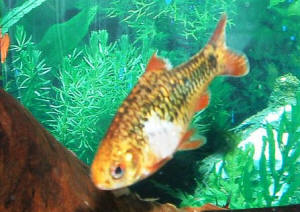 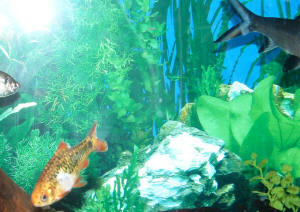
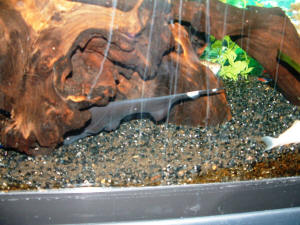 |
Re: angelfish fins
1/20/10
<<And a Bala Shark Neale... See today's Dailies
for the pic... BobF>>
<<<Thanks for this Bob. Are these fin nippers?
Cheers, Neale.>>>
<Can definitely be so... for slow moving fishes with
long, flowing fins... Pterophyllum, you bet. As with many
other Cyprinids... out of their shoal/school numbers of
individuals in particular. Cheers, BobF>
Re: angelfish fins 1/21/10
I received this email by accident, I think...
<<Mmm, no; I send my (and others here) "further
input" to all concerned parties. RMF>>
but yes, I do have two Bala sharks currently. All of my
fish have been given to my by people who no longer want or
can no longer keep their fish. I didn't get any from a
pet store.
<It's good you're rehoming fish, but of course
"no good deed goes unpunished", so there's no
guarantee your waifs and strays will all get along. Indeed,
given people keep friendly fish but want to rehome
difficult fish, the odds aren't in your favour.>
I have had gold barb minnows (I originally had 8 when they
were smaller but now they are down to 5), 2 Bala sharks, 5
black skirt tetras, and the ghost knife (well, I have only
had him the last 6-8 months, with my angels for over a year
with no issue with nipping before. No really, no problems
before. Their fins were beautiful and long. I just noticed
the fins disappearing about the last week or two. But about
a week prior to that is when my ammonia, nitrites and
nitrates were extremely high. I brought it all back down to
0 and have been on top of things. As soon as the tank was
out of whack, I reduced feedings to once a day. That's
why I was wondering if it was fin rot from the bad water or
because they are super duper hungry since I cut their food
in half.
<Possibly both. Certainly poor water quality can cause
Finrot; but hungry barbs and tetras may be more nippy than
otherwise, and thereby cause the physical damage that
triggers or exacerbates bacterial infections.>
I'm still monitoring the water (three weeks later) and
its still all 0, nitrates are at 1.0. I will be doing a
large water change to help with the fins to heal but have
also went back to feeding twice a day but not leaving any
food in the tank. I hope to notice that they fins start to
heal within the next few weeks.
<Would look for changes within a week; if not obviously
stabilised, then begin treating as per Finrot.>
Even before they ate everything I gave them. There was
never anything left over to decay in the tank...
<Cheers, Neale.>
|
|
|
|

